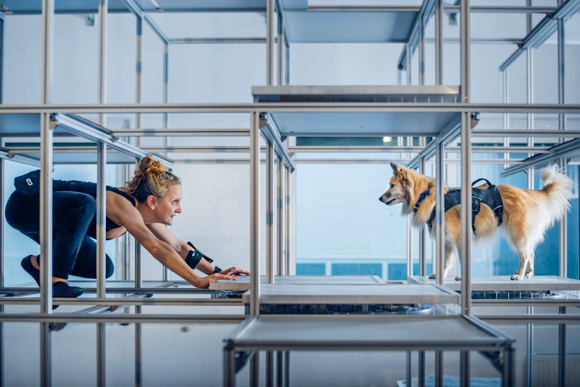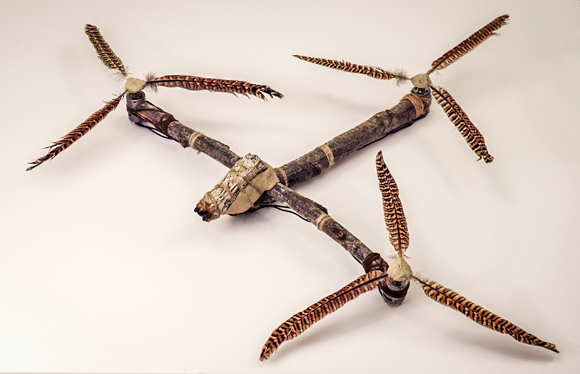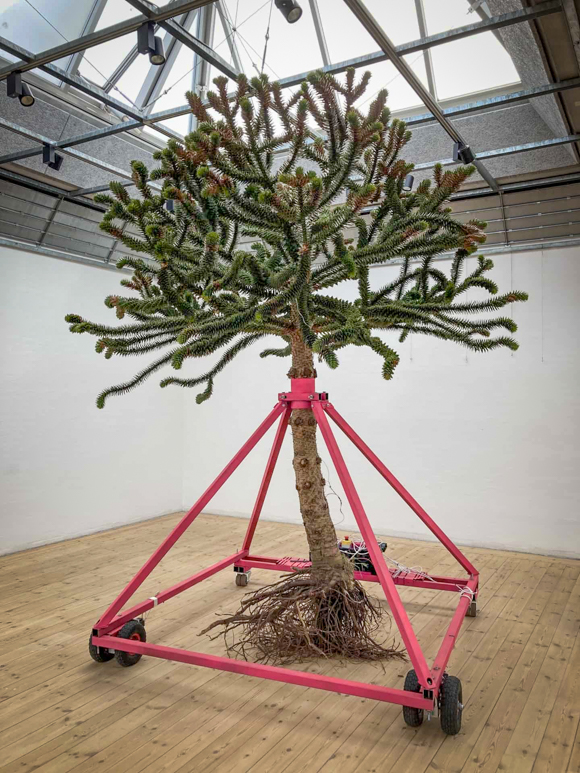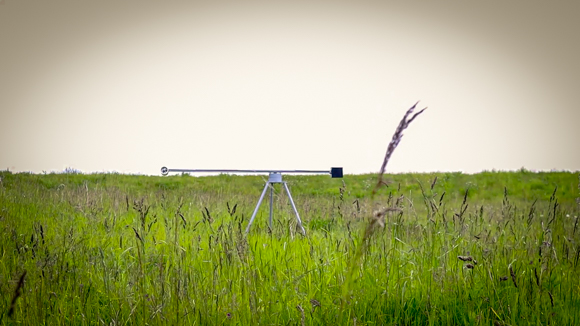Can art make robots better?
Engineers don't just work with mathematical calculations, model drawings on chequered paper and thick reference books full of tables. They also work with art, increasingly so, and this is also the case at the Faculty of Engineering at the University of Southern Denmark. But why exactly?
In some ways, Jonas Jørgensen's office is similar to most of those at the Maersk Mc-Kinney Møller Institute. The walls are white, there's a desk, a computer, quite a few books on shelves, and the fluorescent lights in the ceiling cast a cool light onto the dark linoleum floor. Just like next door.
But then there are also some things that stand out.
Over by the window, for example, there is a black pedestal with a jellyfish-like blob at the top. Occasionally it pulsates as if it were breathing and makes strange clicking and beeping noises.
This is the artwork SONŌ, which he created together with his PhD student Mads Bering Christensen.
In addition to being a lecturer in robotics at the University of Southern Denmark, Jonas Jørgensen is also an artist. He has exhibited his work in galleries and art centres around the world and actively uses artistic work in his research on
”It can cause the whole system to fail
Also, when it comes to robot-human interaction, an aesthetic perspective is almost indispensable, according to the associate professor. Because when humans have to deal with a robot, it matters what it looks like, what it sounds like and its overall behaviour.
- Human-robot interaction is an area where the technical solution is not enough on its own. The technical aspects may be good enough, but if there is something that makes humans dislike the robot, it is not a good thing. If they don't like the way it looks or don't like to touch it, it can cause the whole system to fail," says Jonas Jørgensen.
 !bruce_force: Soft Resilience (2022) -read more at the bottom of the page
!bruce_force: Soft Resilience (2022) -read more at the bottom of the page
But there are, of course, some areas where it may be less relevant to involve the arts, he admits.
-For example, if you have a gripper in a factory where there are no people around, the colour of the gripper may not be that important.
Critical questions
Another important reason why engineers should engage with art is that it can contribute to critical reflection. Through art, you can discuss the new technology, its possible pitfalls and drawbacks, and this can ultimately make the solutions better.
This is according to Dylan Cawthorne, Associate Professor of Drone Technology at the University of Southern Denmark. He too works with art and brings it directly into his research on drones and ethics.
 Electromechanical Sage Bird (2021) -read more at the bottom of the page
Electromechanical Sage Bird (2021) -read more at the bottom of the page
- There are plenty of examples from the science fiction genre, among others, of how art can explore, discuss and criticise technology, he says.
- Just take 'Black Mirror', which asks all those questions. What happens if we lose our loved ones and can make a chatbot that imitates them? This technology does actually exist . And what if you could put the chatbot into a robot so that we never actually lose those who die? What does it mean for our society and us as human beings?
”It is important to ask questions like: Who does this technology actually benefit? Who owns it? Who is in power?
But Dylan Cawthorne also believes that artistic practice can go beyond that.
It's an alternative way of thinking, he says, and he's convinced that it's healthy sometimes to let your brain and hands be free to express yourself without the constraints and demands of necessity and applicability, as you do in art.
- For me, at least, working with art has been absolutely necessary, especially when I've had long periods where my brain has had to work analytically. I can't imagine life without that space.
 Have We Met Before? (2022) -read more at the bottom of the page
Have We Met Before? (2022) -read more at the bottom of the page
Robots in culture and literature
Although robots are a modern technology that has only really been developed and popularised from the 1960s onwards, the robot as a cultural phenomenon goes back much further in history. This is according to Kathrin Maurer, Professor at the Centre for Culture and Technology at the University of Southern Denmark.
- You can actually go all the way back to the Bible, where we find the idea of a golem, an artificial form of life, says Kathrin Maurer.
- The 19th century and Romanticism in particular saw a fascination with robots in culture. You have, for example, a creepy female robot in E.T.A. Hoffmann's 'The Sandman', and of course there's also Mary Shelley's 'Frankenstein'.
”The robots in many recent stories are empathetic, social and loving. They become our partners and carers
Over the years, the view of the robot has changed, and while one should be careful not to generalise and imagine a linear narrative, there are some broad features that recur:
- In Romanticism, the robot often becomes the technologically uncanny, the alien and the ultimate other. Later, for example in Fritz Lang's 1927 film 'Metropolis', the robot is also sexualised, says Kathrin Maurer.
- I've also noticed that in many recent stories, the robots are empathetic, sociable and loving. They become our partners and carers. This can be seen, for example, in Kazuo Ishiguro's latest novel, 'Klara and the Sun'.
 Homage to Technology (2022) -read more at the bottom of the page
Homage to Technology (2022) -read more at the bottom of the page
Interaction with the viewer
The robotic art that Jonas Jørgensen specialises in has also evolved over time. The earliest examples of artistic works that simply consist of robots date back to the 1960s.
- At the time, robotics and cybernetics were in their infancy, and artists such as Nam June Paik, Edward Ihnatowicz and Tom Shannon were experimenting with the possibilities of replacing brushes and canvases with robots. Suddenly, you could create an interaction with the viewer, so that art was no longer just a static object or a kinetic sculpture.
Today, a lot of robotic art is much more critical, says Jonas Jørgensen.
- What characterises more contemporary works, now that robotics has made its way into our society, is a critical stance, which, according to some artists, is missing from the public debate. What are the societal implications and what are the implicit assumptions behind, for example, the idea that robots can alleviate the burden of elderly people?
Are you yourself critical of robots in your art?
- I am affirmatively critical, I would say. I try to ask questions and point to alternatives, says Jonas Jørgensen.
”As engineers, we are by nature technological optimists. We do what we do to make the world better, but I think we should be much more self-critical
Dylan Cawthorne would also describe himself as sceptical of technology, both in his art and in his research.
- It is important to ask questions like: Who does this technology actually benefit? Who owns it? Who is in power?" he says.
- As engineers, we are by nature technological optimists. We do what we do to make the world a better place, but I think we should be much more self-critical. It's easy to get caught up in the bubble of the tech world and forget to consider the problems that technology can also create.
And art can help with that?
- Yes.
Elaborate image texts:
SON Ō (2020-2022) by Jonas Jørgensen and Mads Bering Christensen: The piece consists of a jellyfish-like robot with bladders that inflate and deflate to make it look like it is breathing. The breathing changes speed and intensity according to the robot's mood, and it makes squeaking and clicking sounds. The work is an exploration of how soft robots sound and what this means for our perception of them.
Tales of C (2017-2018) by Jonas Jørgensen: An octopus-like robot swims around in an aquarium. At the same time, a computer-generated voice is heard reading randomly selected fragments of philosophical, scientific, journalistic and historical texts about octopuses and technology. Perhaps the two phenomena have more in common than you might think?
!bruce_force: Soft Resilience (2022) by Jonas Jørgensen and Maja Smekrar: Artist Maja Smekrar and a live dog crawl through an open grid structure while an artificial intelligence collects physiological data about them, telling them where and how to move and ultimately synchronising their heart rhythms. The performance is about data collection, about a new market economy, and about what the new technological reality means for both humans and non-humans.
Electromechanical Sage Bird (2021) by Dylan Cawthorne: The work, according to the artist, is a "kinetic sculpture that aims to subvert the "high-tech-ness" of drones while promoting values such as spirituality and sustainability". It is made from rough pieces of wood bound together by hemp fibres and with quail feathers instead of propellers. Usually drones carry a payload - a camera, for example - but here it consists of burning sage , which in several indigenous North American cultures was said to have a healing, spiritual effect.
Have We Met Before? (2022) by Dylan Cawthorne, Alexander Sokolovs, Karsten Nymand and Morten Tryk: A monkey tree is placed on a rolling stand with a motor. Using sensors attached to the tree, the tree itself can move around the room as it pleases. The work is an example of how technology does not necessarily have to be designed solely for human needs and at the expense of plants and animals.
Homage to Technology (2022) by Dylan Cawthorne: A rotating wing with a jet engine starts to slowly spin round in a circle. At first it is calm, but gradually it gets faster and faster, not moving out of place, but going round in circles, using electricity and making noise and finally rotating so violently that the sculpture destroys itself.
Meet the researcher
Jonas Jørgensen has a degree in physics and art history and is an associate professor at SDU Biorobotics at the Maersk Mc-Kinney Møller Institute. His research centres on soft robots and human-robot interaction.